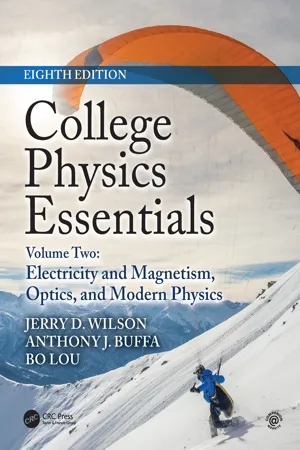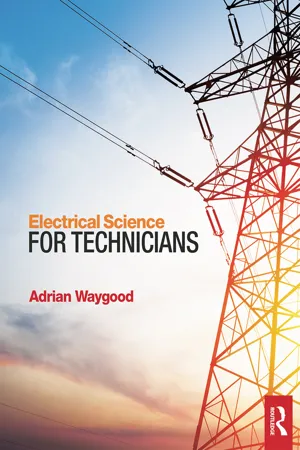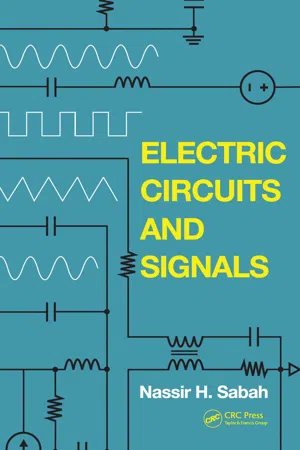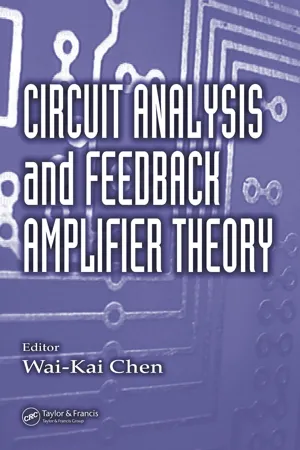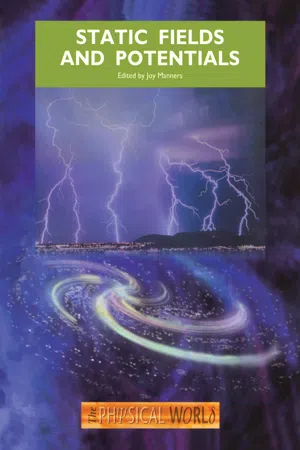Physics
Kirchhoff's Loop Rule
Kirchhoff's Loop Rule, also known as Kirchhoff's Voltage Law, states that the sum of the voltage drops around any closed loop in a circuit is equal to the electromotive force in the loop. This rule is based on the principle of conservation of energy and is used to analyze and solve complex electrical circuits by considering the voltage changes around closed loops.
Written by Perlego with AI-assistance
Related key terms
Related key terms
1 of 4
Related key terms
1 of 3
9 Key excerpts on "Kirchhoff's Loop Rule"
- eBook - ePub
College Physics Essentials, Eighth Edition
Electricity and Magnetism, Optics, Modern Physics (Volume Two)
- Jerry D. Wilson, Anthony J. Buffa, Bo Lou(Authors)
- 2019(Publication Date)
- CRC Press(Publisher)
assumed. Then the currents are calculated, without worry about direction. If some of the assumed directions are opposite the actual resulting directions, then negative answers for these will result. In other words, the mathematical outcome will show that the directions of the actual currents are opposite to the directions initially assumed.18.2.2 Kirchhoff’s Loop TheoremKirchhoff’s second rule , or loop theorem , states that the algebraic sum of the potential differences (voltages) across all of the elements of any closed loop is zero:∑ ΔV i= 0 ( sum of voltages around a closed loop )(18.5) Thus the sum of the voltage gains (i.e., an increase in potential) equals the sum of the voltage drops (i.e., a decrease in potential) around a closed loop, which must be true if energy is conserved. (This rule was used in analyzing series resistances in Section 18.1.)Notice that the direction chosen to traverse a circuit element will yield either a voltage rise or a voltage drop, depending on the direction. Thus, it is also important to establish a sign convention for voltages. The conventions used here are illustrated in ▶ Figure 18.7 . The voltage across a battery is taken as positive (potential rise) if it is traversed from cathode (− ) to anode (+ ) terminal (Figure 18.7a ) and negative (potential drop) if it is traversed from anode to cathode. (Note that the direction of the current through the battery has nothing to do with these signs. The sign of the battery voltage depends only on the direction chosen to cross it.)▲ Figure 18.7 Sign convention for Kirchhoff’s loop theorem (a) The battery voltage is taken as positive (a gain) if it is traversed from the negative to the positive terminal. It is assigned a negative value if traversed from the positive to the negative (a drop). (b) - eBook - ePub
Basic Electric Circuit Theory
A One-Semester Text
- Isaak D. Mayergoyz, W. Lawson(Authors)
- 2012(Publication Date)
- Academic Press(Publisher)
4 = 0 as claimed. Second, note that the negative sum of the two cut set equations is equal to the KCL equation for node D (the only node which is not contained within a cut set). This example clearly demonstrates that the cut set equations follow from the node equations (and vice versa) and leads us to the notion of independent equations, which will be discussed later in this chapter.2.3.2 Kirchhoff’s Voltage Law
Kirchhoff’s voltage law is the second fundamental axiom of circuit theory and is often abbreviated as KVL. KVL is applied to voltages in loops and states that the algebraic sum of branch voltages around any loop of an electric circuit is equal to zero at every instant of time. Mathematically, it can be written as follows:(2.2)To actually write KVL equations, we shall need the following rule for voltage polarities. We start by introducing reference voltage polarities for each branch. (Remember that these reference voltages are coordinated with the reference currents for the passive elements.) Then, we trace each loop in an arbitrary direction (it is helpful to trace every loop in the same direction—so let us always agree to go clockwise in this text). If, while tracing through the loop, we enter the “plus” terminal of an element and exit its “minus” terminal, then we take the voltage across this element with a positive sign. If, on the other hand, we enter the negative terminal while tracing the loop, we take the corresponding voltage with a negative sign.To demonstrate the above rule, consider the example circuit shown in Figure 2.6 with the loops already labeled (keep in mind that these are not the only possible loops for this circuit). KVL for loop I in Figure 2.6 yields − v 1 + v 3 + v 2 = 0. Likewise, for loop III we will get − v 5 − v 6 + v 9 = 0 from KVL.Figure 2.6 Example circuit with four loops shown as I, II, III, IV.Since for passive elements, reference polarities for voltage and reference directions for current are coordinated, we can formulate the rule for determining the signs of branch voltages in a KVL equation in terms of the reference current directions. Namely, if the tracing direction coincides with the reference current direction, the branch voltage is taken with a positive sign in the KVL equation. Otherwise, the branch voltage requires a minus sign in the KVL equation. In loop I, the tracing direction coincides with reference directions of i 2 and i 3 but is opposite to i 1 , so we would get − v 1 + v 3 + v 2 = 0 as we must.Because the reference current directions and voltage polarities are not necessarily coordinated for sources, one should always use the previous rule for voltage polarities to evaluate the signs of the voltages across the sources in the KVL equations. - Jaap Hoekstra(Author)
- 2016(Publication Date)
- Jenny Stanford Publishing(Publisher)
postulates of circuit theory. They hold irrespective of the nature of the elements constituting the circuit. Both reflect topological properties of the circuit.On the basis of the fundamental law of physics that electric charge is conserved, KCL for nodes states that, for all times t , the algebraic sum of the currents i 1 , i 2 ,...,in leavingany node is equal to zero:Σ ni n( t )= 0.( 6.1 )Given any connected lumped circuit having n nodes, we may choose arbitrarily one of these nodes as a datum node, that is, as a reference for measuring (electric) potentials u 1 , u 2 ,..., u n−1 . Let v i denote the voltage (potential) difference across branch (element) i connected between node k and j. KVL states that, for all choices of the datum node, for all times t , and for all pairs of nodes k and jv i( t )=u k( t )−u j( t ).( 6.2 )If we now consider a closed node sequence, thus starting and ending at the same node, the voltage difference must be zero. Now, KVL states that, for all closed node sequences (loops), for all times t , the algebraic sum of all node-to-node voltages (voltage differences) around the chosen closed node sequence is equal to zero:Σ nv n( t )= 0.( 6.3 )KCL and KVL always lead to homogeneous linear algebraic equations with constant real coefficients .6.1.2 Circuit ElementsA circuit is characterized by one or more sources of electrical energy, interconnected with one or more receivers, or sinks of electrical energy. In fact, in the circuit energy is supplied by sources, transferred from one place in the circuit to another, and temporarily stored or dissipated in circuit elements. In general, for the circuit holds the principle of conservation of energy. The sum of the energy delivered by the independent sources in the circuit is equal to the energy absorbed by all other elements of the circuit (see Section 6.2.1- eBook - ePub
Foundations of Electromagnetic Compatibility
with Practical Applications
- Bogdan Adamczyk(Author)
- 2017(Publication Date)
- Wiley(Publisher)
To illustrate KVL, let us consider a circuit shown in Figure 7.21. Figure 7.21 Illustration of the Kirchhoff’s voltage law. Suppose, we start with the voltage source v s 1 and traverse the loop in the clockwise direction. Applying KVL yields (7.110) In traversing the element, when going from + to –, we refer to the voltage as the voltage drop, whereas when going from – to +, we talk about a voltage rise. In general, KVL can be expressed as the algebraic sum (7.111) where N is the number of voltages in the loop and v k is the k th voltage. Example 7.4 Voltage sources in series A simple application of KVL is combining voltage sources in series. For example, the voltage sources shown in Figure 7.22 (a) can be combined as shown in Figure 7.22 (b). Figure 7.22 Combining voltage sources in series. The equivalent voltage source in Figure 7.22 (b) is obtained by applying KVL: (7.112a) or equivalently (7.112b) When the voltage sources are in series, the equivalent voltage is the algebraic sum of the voltages of the individual sources. Note: A circuit cannot contain two different voltage sources in parallel, unless they are equal, otherwise the law of conservation of energy is violated. 7.3.8 Kirchhoff’s Laws in the Phasor Domain Kirchhoff’s Current Law Let the KCL in the time domain be stated as (7.113) or, equivalently (7.114) KCL holds for any time function of currents. Let each current in Eq. (7.113) be sinusoidal of the form (7.115) Then the corresponding phasor is (7.116) It follows that Eq. (7.114) can be written in the phasor form as (7.117) Eq. (7.117) represents KCL in the phasor domain. Kirchhoff’s Voltage Law Let the KVL in the time domain be stated as (7.118) or, equivalently (7.119) Let each voltage in Eq - eBook - ePub
- Adrian Waygood(Author)
- 2015(Publication Date)
- Routledge(Publisher)
don’t .Figure 1.11Kirchhoff’s Laws
Kirchhoff’s Laws are named in honour of the Prussian physicist, Gustav Kirchhoff (1824–1887), who formulated these laws while he was still a student.His two laws apply to all categories of circuit, and it is very important to understand these laws if we are to understand the behaviour of voltages and currents in any circuit, whether simple or complicated.There are two laws called, respectively, ‘Kirchhoff’s Current Law’ and ‘Kirchhoff’s Voltage Law’, as outlined below.Kirchhoff’s Current Law
Kirchhoff’s Current Law may be expressed as follows:Kirchhoff’s Current Law states that ‘the algebraic sum of the currents at any junction is zero ’.Let’s apply this law to the circuit shown in Figure 1.12 :Figure 1.12In this particular circuit, there are three ‘junctions’ or ‘nodes’, labelled A, B, and C.► At junction A, the current (I 1 ) approaching that junction must be equal to the sum of the two currents, I 2 and I 3 , leaving that junction. i.e.:(I 1 = I 2 + I 3 ) or (I 1 − I 2 − I 3 = 0)► At junction B, the current (I 2 ) approaching that junction must be equal to the sum of the two currents, I 4 and I 5 , leaving that junction. i.e.:(I 2 = I 4 + I 5 ) or (I 2 − I 4 − I 5 = 0)► Finally, at junction C, the sum of the three currents (I 3 +I 4 +I 5 ) approaching that junction must be equal to the current, I 6 , leaving that junction. i.e.:(I 3 + I 4 + I 5 = I 6 ) or (I 3 + I 4 + I 5 − I 6 = 0)And, of course, current I 6 is exactly the same current as I 1 . So, in the above expression, if we wished, we could simply replace current label I 6 with I 1 .It is a misconception to think that the current approaching - eBook - ePub
- Nassir H. Sabah(Author)
- 2017(Publication Date)
- CRC Press(Publisher)
2Basic Circuit Connections and Laws
Overview
There are two basic circuit laws, known as Kirchhoff’s laws, which are expressions of conservation of charge and conservation of energy. They must be obeyed, therefore, by electric circuits under all conditions, independently of the circuit configuration and the circuit elements involved.Kirchhoff’s laws are first applied in this chapter to analyze some simple circuits, namely, resistive voltage dividers and current dividers. These simple circuits feature the two basic circuit connections: the series and parallel connections. Circuit elements connected in series or in parallel can be combined with other circuit elements in series or in parallel combinations to obtain circuits of any desired complexity. When resistors are connected in series or in parallel, the individual resistances or conductances combine according to some simple rules to give an equivalent resistance or conductance. The concept of equivalence is fundamental to circuit analysis and is applied to the Δ-Y transformation and transformation between voltage and current sources.The voltage divider supplying a load at a reduced voltage is considered at the end of the chapter to illustrate a common and important feature of engineering design in general, namely, the trade-off between conflicting performance requirements. The example also illustrates the practical effects of tolerance of resistance values due to inevitable variations in component values during manufacturing. - eBook - ePub
- Isaak D Mayergoyz, Patrick McAvoy(Authors)
- 2014(Publication Date)
- WSPC(Publisher)
Previously we discussed the terminal relations, which are determined by the physical nature of the circuit elements. Now, we proceed to the brief discussion of the relations which are due to the connectivity of elements in an electric circuit. There are two types of such relations. We begin with the Kirchhoff Current Law (KCL). KCL equations are written for nodes of electric circuits. A node of an electric circuit is a “point” where three or more elements are connected together. KCL states that the algebraic sum of electric currents at any node of an electric circuit is equal to zero at every instant of time. This is mathematically expressed as follows:The term “algebraic sum” implies that some currents are taken with positive signs while others are taken with negative signs. Two equivalent rules can be used for sign assignments. One rule is that positive signs are assigned to currents with reference directions toward the node, while negative signs are assigned to currents with reference directions from the node. KCL equations can be written for any node. However, only (n − 1) equations will be linearly independent, where n is the number of nodes in a given circuit. The (n − 1) nodes for which KCL equations are written can be chosen arbitrarily. The KCL equation for the last (n-th) node can be obtained by summing up the previously written KCL equations. This clearly suggests that the equation for the last (n-th) node is not linearly independent. A “point” in an electric circuit where only two elements are connected is not qualified as a node because of the triviality of the KCL equation in this case, which simply suggests that the same current flows through both circuit elements, i.e., these two circuit elements are connected in series.Next, we discuss equations written by using the Kirchhoff Voltage Law (KVL). These equations are written for loops. A loop is defined as a set of branches that form a closed path with the property that each node is encountered only once as the loop is traced. A branch is defined as a single two-terminal element or several two-terminal elements connected in series. KVL states that the algebraic sum of branch voltages around any loop of an electric circuit is equal to zero at every instant of time. This is mathematically expressed as follows: - eBook - ePub
- Wai-Kai Chen, Wai-Kai Chen(Authors)
- 2018(Publication Date)
- CRC Press(Publisher)
voltage drop. If the signs of a voltage are reversed and a negative sign is affixed to the voltage variable, the value of that variable remains unchanged; thus, note that a negative rise is a drop, and vice versa.We are now in a position to state our fourth and final axiom:Axiom 4 (Kirchhoff’s Voltage Law): The sum of the voltage rises around any loop is identically zero at all instants of time.We refer to this law as KVL for the sake of economy of space. Just as KCL was phrased in terms of charge, KVL could just as well be phrased in terms of flux linkage. Flux linkage is the time integral of voltage, so it can be said that the sum of the flux linkages around a loop is zero. In voltage form, we write
We observed that a negative rise is a drop, so∑ loopv rises= 0(2.8)
or∑ loopv drops= 0(2.9) ∑ loopv rises=∑ loopv drops(2.10) Thus, in Figure 2.13 , we could write [should we choose to use the form of (2.8) ]FIGURE 2.13 Illustration of Kirchhoff’s voltage law.FIGURE 2.14 Path form of KVL.v x−v y−v a+v b= 0(2.11) Clearly, one can rearrange KVL into many different algebraic forms that are equivalent to those just stated; one form, however, is more useful in circuit computations than many others. It is known as the path form of KVL. To better appreciate this form, review Figure 2.13 . This time, however, the paths are defined a bit differently. As illustrated in Figure 2.14 , we consider two paths, P1 and P2 , having the same initial and terminal nodes, 1 and 4, respectively.2 We can rearrange (2.11) - eBook - ePub
- Joy Manners(Author)
- 2020(Publication Date)
- CRC Press(Publisher)
Kirchhoff's laws can be used in more complicated circuits where all the directions of the currents are not necessarily known, as the following worked example demonstrates.Example 3.3Figure 3.19 shows a circuit containing four resistors with resistances R1 , R2 , R3 and R4 , a voltmeter and a battery. This network is particularly important and is known as a Wheatstone bridge circuit. By applying Kirchhoff's first law to the closed paths ABDA and BCDB, show that, in general, if the voltmeter reads zero, then R1 R3 = R2 /R4 . (Assume that all connecting wires have negligible resistance.)Figure 3.19 A Wheatstone bridge circuitFigure 3.20 For use with Question 3.5.SolutionThe assumed current directions are shown on the figure. In numerical problems, the choice of directions of currents and potential drops is arbitrary. If we choose the wrong direction, the current will come out negative, which means that a current (or potential drop) is in the opposite direction to the one we chose. Note that when a circuit loop is specified, such as BCDB, the sense round it is determined by the ordering of the letters.The total current flowing through the battery is labelled i, and i13 flows along ABC and 124 along ADC. No current flows along BD since there is zero potential difference between B and D (the voltmeter reads zero).Applying Kirchhoff's first law to the loop ABDA soAround the loop BCDB so(i)−i 13R 1+i 24R 2= 0i 13R 1=i 24R 2.(ii)−i 13R 3+i 24R 4= 0i 13R 3=i 24R 4.The negative signs are required because, with the currents in the directions chosen and the chosen senses round the loops, there would be a potential drop across R1 and across R3 .Since, in both of the equations (i) and (ii), the left-hand side is equal to the right-hand side (by definition), the ratio of the left-hand side of (i) to the left-hand side of (ii) must be equal to the ratio of the right-hand side of (i) to the right-hand side of (ii).
Index pages curate the most relevant extracts from our library of academic textbooks. They’ve been created using an in-house natural language model (NLM), each adding context and meaning to key research topics.
Explore more topic indexes
Explore more topic indexes
1 of 6
Explore more topic indexes
1 of 4
